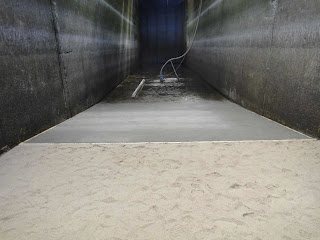Couldn't resist this final, final post beore departing with a plot of all instrument positions. Enjoy!
BARDEX II (Barrier Dynamics Experiment) is a research projected funded by the European Union and takes place in the Delta Flume in the Netherlands from May to July. The overall aim of the project is to increase our understanding of sediment transport processes on sandy beaches. The project is hosted by Deltares and 25 researchers from 9 different universities (Algarve, Bordeaux, Copenhagen, Delaware, New Hampshire, New South Wales, Plymouth, Southampton, Utrecht) are involved.
Thursday 31 May 2012
Time table
 My last post before heading off to the flume. I thought it be useful to post the provisional time table (note: you can makes images full-size by clicking on them). Please note the word 'provisional' - this is the plan. We might lose some days, and things might have to be moved around a bit. Being flexible is being prepared!
My last post before heading off to the flume. I thought it be useful to post the provisional time table (note: you can makes images full-size by clicking on them). Please note the word 'provisional' - this is the plan. We might lose some days, and things might have to be moved around a bit. Being flexible is being prepared!Wednesday 30 May 2012
Time's ticking
Not much to report, really. Plymouth have all their kit collated and are slightly worried whether it will all fit in the CPRG van; Martin and Dan have calibrated the pressure sensors; Thijs has finished potting up an extra batch of conductivity concentration probes; Tim P has carried out some maintenance on the bed-level sensors; and I am checking lists. Keep an eye out for the CPRG van - we are almost on our way!
 |
| CPRG van on Loe Bar, Cornwall (emu had escaped form farm). |
Monday 28 May 2012
Chalet accommodation
 For those who haven't checked out our luxury holiday accommodation on the Akkertien campsite, please check out their website for some photos of the cabins. The small map to the right shows the cabin interior. Note that there are three beds in the second bedroom (one of the beds shown is a bunk bed). I am intending to bring some extra tables so we can sort out some decent office space - after all, we'll be there for 5 weeks so we might as well make ourselves comfortable.
For those who haven't checked out our luxury holiday accommodation on the Akkertien campsite, please check out their website for some photos of the cabins. The small map to the right shows the cabin interior. Note that there are three beds in the second bedroom (one of the beds shown is a bunk bed). I am intending to bring some extra tables so we can sort out some decent office space - after all, we'll be there for 5 weeks so we might as well make ourselves comfortable.Electro-magnetic current meters
 The Delta Flume staff have finished wall mounting the electro-magnetic current meters. Three vertical arrays of current meters at 0.1, 0.3 and 0.5 m from the bed have been installed to span the surf zone and a single current meter mounted at 0.25 m from the bed will be used to record 'offshore' current velocities.
The Delta Flume staff have finished wall mounting the electro-magnetic current meters. Three vertical arrays of current meters at 0.1, 0.3 and 0.5 m from the bed have been installed to span the surf zone and a single current meter mounted at 0.25 m from the bed will be used to record 'offshore' current velocities.Tuesday 22 May 2012
Swash rig
The figure below shows the configuration of the main swash rig, to be deployed in the bottom part of the swash zone. The rig includes equipment from Universities of Delaware, New South Wales and Plymouth.
Monday 21 May 2012
Beach is finished
After many days of shovelling and digging and shaping and packing, the 4.5-m high and 50-m (above sea level) wide BARDEX II beach has been constructed. Total amount of sand used: 1400 cubic meters. Next phase of the work will be the fixing to the wall of Deltares hydrodynamic equipment, and then ... the arrival of the international research teams on the 4th of June with their equipment.
 |
| View of the barrier from the back of the barrier towards the wave paddle, located c. 100 from the crest of the barrier. |
Preliminary modelling
The French team (Bruno Castelle and Philippe Bonneton) have been doing some preliminary numerical modelling to give us some idea of what to expect and help us decide where to put our instruments. The animated gifs below show some of the model runs. For more infomation, please ask Bruno or Philippe.
| Swash action predicted by Phippe's model. |
 |
| Overwash conditions predicted by Bruno's model |
Saturday 19 May 2012
Some pictures from the flume during preparation
Here are some photos from the flume during construction of the barrier and installation of Deltares equipment during April and May 2012. Note distinct lack of hard hats!
 |
| Seaward of the sandy beach, a 20-m wide and 0.5-m layer of sand is placed. In front of this sand layer, a 10-m wide concrete toe with a 1:20 gradient is present. |
 |
| After installation of the piezometers and construction of the retaining wall and concrete toe, the 4.5-m high and 50-m wide barrier can be constructed. |
Friday 18 May 2012
T-shirts have arrived
Thursday 17 May 2012
Welcome to BARDEX II
In 2008, Dan Buscombe kept people up to date with progress with BARDEX experiment using a blog: BARDEX2008.blogspot.co.uk. People found this quite useful, so I will try and do the same, although I am unlikely to be as entertaining as Dan was.
Subscribe to:
Posts (Atom)





